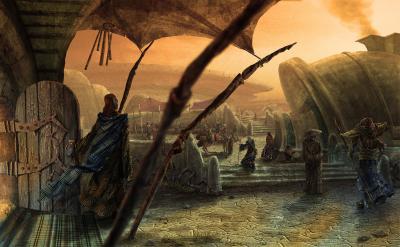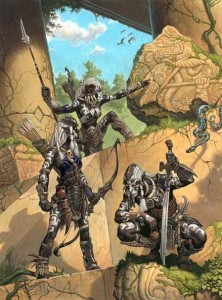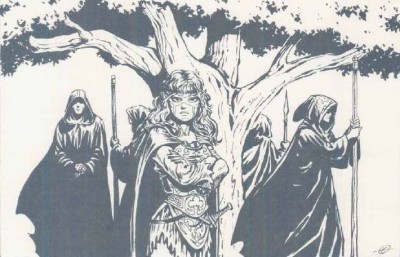Humans are one of the minor people who live in the Ancient Lands. They consist of four major tribes that are very different from each other and live separated by many hundreds of miles from one another. They have been few in numbers and of little importance in the history of the Ancient Lands for the most time, but in recent centuries Vandren from the Vestanen Mountains have been coming into the lands on the Inner Sea in increasing numbers and started to settle in some parts of the lowlands. There are still many Falden or Ruyaki who have never seen a human in their entire life, and with the exception of the Amakari in Sunvanea they are almost unknown to the lizardmen of the Mahiri Jungles and Kemesh. Humans are very similar in height and stature to elves, though usually somewhat bulkier build. By the age of 20 they are fully grown, but rarely live for more than 80 years and even that is very rare except for some powerful shamans and witches.
Even though humans are not as strong as kaas or lizardmen and lack the speed and agility of elves, they have an endurance toughness that beats that of all the other humanoid people. As long as they have sufficient water, humans can travel almost an entire day with very little rest, even in heat that brings the strongest kaas or elves down within an hour and they can keep doing so for many days with only little food. Humans who are traveling light can easily cover as much distance in a day as a horse, and even outdistance them on a hot day. Scouts and patrols of other people rarely attempt to pursue humans who have a good head start as the chances for catching them are slim. And outrunning human pursuers on foot is a situation in which even the most experienced and toughened never wish to find themselves. Skeyn may have a similar ability to keep up hard physical work for long time, but nobody outruns even a moderately healthy human over long distances. In addition to that, humans are also exceptionally hardy when it comes to dealing with malnutrition and the various diseases that often accompany it. They are able to survive on a wider range of food sources than almost anyone else and it’s often said that there is nothing sold as food in the markets of the Ancient Lands that humans couldn’t digest. Their bodies are also able to deal reasonably well with food that has been partly spoiled and become inedible to other people without becoming thick. In the centuries in which human mercenaries have been hired by elven warlords, it has become well known that they will almost always outlast nonhuman enemies in a siege, regardless of which side of the walls they are on. Unsurprisingly, this has made them highly valued as mercenaries for the wood elven tribes and Amakari slaves often bring the best prices for Takari slavers. In recent generations they have even started to be hired as sailors on Keyren ships.
Amakari
The Amakari are one of the two tribes that inhabit the countless islands of Suvanea in the eastern waters of the Inner Sea. They are taller and broader build than humans of the other tribes and have deep brown skin with dark earth and sand colored hair and beards. They are not very numerous, even in their home islands, which they are sharing with the Gandju lizardmen. Amakari technology is very similar to that of the Gandju and uses almost no metal except for a few small ornaments. They travel between islands and catch fish in small but very fast boats that can be both sailed and rowed. They have the fewest similarities to other human tribes and some think that they might actually be neither humans nor elves, but something else entirely.
Kaska
The Kaska are a small tribe that is very similar in appearance to the Vandren of the Vestanen Mountains and speaks a similar language, but as at home many hundreds of miles to the north in the Witchfens between the great Nareven forest and the Rayalka Moutains. They are of similar height to Vandren and wood elves and have straight black hair and light brown skin. The Kaska are very reclusive and usually hostile to people of any other tribes, but many of the neighboring people believe that they are fighting just as much among themselves. Not much is known about them by people from other lands, as the Witchfens are a highly inhospitable place and nobody is sure what drive the Kaska to make their homes there in the first place. Kaska warparties regularly creep through the hills of the Erhait to raid villages in the valley of the Kaldaven for weapons, grain, and slaves. Within the Witchfens, the true power over the Kaska clans lies in the hands of their witches. Most of them are women who have great power over the clan chiefs, but they also have their own hierarchies and rivalries of which even the common Kaska understand very little.
Mari
The cold northern land of Venlad on the coast of the Northern Sea is the home of the Mari, a small human tribe that has lived mostly in isolation from the rest of the Ancient Lands for countless centuries. Unlike other humans or elves they have relatively light skin and brown hair and they tend to be somewhat taller than most of these people, though not as big as the Amakari. Most Mari are reindeer herders or fishermen, since the cold land doesn’t lend itself well to growing crops. Villages are small and most houses built partly into the ground to be protected from the fierce winter storms, but there are also a few small towns of wooden houses on the coast where ships from the South come during the summer to trade for pelts, whalebone, and dried fish.
Vandren
The Vandren are the largest of the human tribes that live in the Ancient Lands and have their traditional homeland in the Vestanen Mountains between the forests of Nareven and the Red River. They are similar in height to most elves with black hair and light brown skin and make many of their clothes and armor from leather, as they keep many herds of goats, sheep, and mountain horses to survive in a land where growing crops is hard and difficult work. Though gold, silver, and copper can be found in the mountains, the greatest treasure of the Vandren is salt, which they trade with merchants from all over the Ancient Lands. For several centuries elven merchants have been hiring Vandren warriors to protect the valuable caravans from bandits and the warriors of hostile clans, and they soon began to employ large numbers of Vandren mercenaries in their wars against each other. Vandren have been migrating from the mountains to the borders of the elven lands ever since, and while still mostly disorganized and relatively few in numbers, they are becoming a new powerful tribe on the coast of the Inner Sea.
The most famous of the Vandren mercenaries are the Sakaya, who began as a religious group in the Vestanen Mountains that had its own warriors to protects its great monasteries and farming villages. During times of peace, these warrior monks took up mercenary work to hone their skills of combat, but some never returned to the mountains and instead made their new homes in the conquered fortresses of their defeated enemies. Though the Sakaya of the lowlands accept warriors of any tribe or clan into their ranks, the majority of them are still Vandren, and for many people on the Inner Sea there is very little difference between the two.
 While a bit crude and dusty by now, given that they are almost a hundred years old, Edgar Burroughs space fantasy novels set on Mars had a huge impact on fantasy and science-fiction that surely equals Conan and The Lord of the Rings, even though few people still know about. It’s the primary source that inspired Star Wars to the point that you may call the first movie a rippoff, and it will be instantly familiar to any fan of the Dungeons & Dragons setting Dark Sun. There was a movie a few years back with the unfortunate name “John Carter”, which I think was pretty decent, but got not a lot of notice, and which I am assuming is the reason why this game is named the way it is. Even though I personally wouldn’t have any interest to run a campaign in which said character appears. There is so much more to the world than this one guy, who isn’t a particularly great character either.
While a bit crude and dusty by now, given that they are almost a hundred years old, Edgar Burroughs space fantasy novels set on Mars had a huge impact on fantasy and science-fiction that surely equals Conan and The Lord of the Rings, even though few people still know about. It’s the primary source that inspired Star Wars to the point that you may call the first movie a rippoff, and it will be instantly familiar to any fan of the Dungeons & Dragons setting Dark Sun. There was a movie a few years back with the unfortunate name “John Carter”, which I think was pretty decent, but got not a lot of notice, and which I am assuming is the reason why this game is named the way it is. Even though I personally wouldn’t have any interest to run a campaign in which said character appears. There is so much more to the world than this one guy, who isn’t a particularly great character either.


